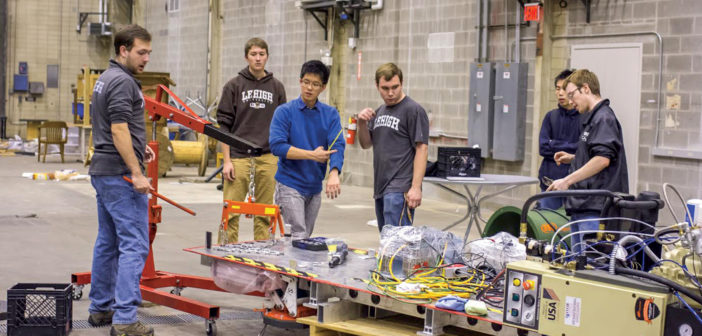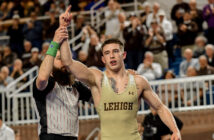In 2017, Lehigh’s Hyperloop club made it to the third phase of the SpaceX Hyperloop competition, which challenges students to design and build a transport pod prototype.
Team members submitted a final design package in the fall. Though they soon learned they would not advance to the next round, they were not disheartened. Instead, the group used it as an opportunity to switch gears.
Raymond Tetyevsky, ’20, a team captain, said Hyperloop pods need specific high-tech rails and tunnels to function, which club members did not have access to, leaving them unsure of how their pod would perform once installed.
“We’ve decided the best thing is to detach ourselves from (Hyperloop) and move on to bigger and better things,” Tetyevsky said. “Something that will make a difference (at Lehigh).”
Alexander Radetsky, ’20, a team captain, said club members spent the last two years developing hyperloop-related pods. They want their next project to be short-term and relevant — something the team can visualize and implement in the moment.
That’s when an old prospect became a new goal.
The club’s attention was redirected toward a competition it had discovered in September but set aside during the Hyperloop competition.
HeroX’s “GoFly” challenges competitors to create a personal flying device that achieves vertical takeoff and landing, travels a minimum of 20 nautical miles and can carry one person.
“We’ve always been a transportation-oriented club,” Radetsky said. “GoFly is a competition that targets a different form of transportation: aerospace.”
Tetyevsky said the GoFly competition will last about two to three years. The first of three phases — research, development and design of the product — is due April 18.
Gencer Ates, ’19, a team captain, said the team has met tighter deadlines.
The second phase of the competition involves design implementation and phase three is constructing the craft. Once constructed and tested, the prototype will be brought to the location of the competition, which is still undetermined.
Nithin Rajaram, ’20, the club’s engineering and simulation leader, said there is a $2 million cash grand prize and many smaller cash prizes within the three phases. Goals within these phases include creating the quietest, fastest or most innovative design.
In addition to competition goals, team members have their own objectives.
Radetsky said the team would like the prototype to fit in the back of a pickup truck so it can be transported for testing, which could not be done with the Hyperloop.
Tetyevsky said he wants to promote safety.
Although he is excited for the project, Radetsky said the transition will be difficult. He said the flight dynamics for a craft like this are similar to taking off in a helicopter and switching to an airplane, mid-flight.
GoFly is not the only project the club is working on. Tetyevsky said it is also in the early stages of developing a project for Lehigh’s campus.
“We’re designing a new transportation system for Lehigh,” Tetyevsky said. “Something that’s greener, that would eliminate the diesel buses running up and down the Hill all the time, quieter, because those buses make a lot of noise, something quicker and something safer. On icy mornings, that hill is treacherous.”
The team is hoping to get involvement from railway companies in the Bethlehem area that were active in the past. Radetsky said they want the transportation system to be Lehigh-specific.
“It’s going to be a project designed and implemented by students,” Tetyevsky said. “To us, it is very important to build something that is sustainable for the club and for the other engineers that are coming in as freshmen, something that will be passed on well beyond when we leave.”
Because the team is no longer working on the Hyperloop project, the name of the club will be changed.
“It’s not a niche club, it’s not focused on only one particular thing,” Tetyevsky said. “We’re trying to develop (a name) that incorporates not just what we do, but who are.”
As the team’s objectives change, so will the structure.
Ates said that last year, mainly experienced upperclassmen had active roles in the club because they had the skills to design the Hyperloop. Now, the team is implementing a new system that allows all members to participate on at a more equal level.
Rajaram said older club members are now working to teach new members the skills and techniques they need, rather than taking on all the work themselves.
Hyperloop members come from a variety of engineering and business backgrounds, which allows members to work on multiple projects. The interdisciplinary nature of the team, however, was not always seen as a positive thing.
Radetsky said the divide between the business and engineering students was once clear. Now, IBE students oversee and integrate the two sides.
Ates said that anyone can join the club, regardless of major.
“As to what we can accomplish, we realize — which I think was a fault of the group before the restructure — how much people are capable of until you let them go,” Tetyevsky said. “You tell them less and they’ll give you more.”






Comment policy
Comments posted to The Brown and White website are reviewed by a moderator before being approved. Incendiary speech or harassing language, including comments targeted at individuals, may be deemed unacceptable and not published. Spam and other soliciting will also be declined.
The Brown and White also reserves the right to not publish entirely anonymous comments.
1 Comment
Eastern Pennsylvania has some past examples of transport systems such as the gravity railroad from Scranton northeastward to the Delaware River, the Ashley Plane near Wilkes Barre and the Mauch Chunk Railway near the Asa Packer Mansion in present day Jim Thorpe. Electrified railways use energy going uphill but can generate energy going downhill. Air pressure has also been used to move objects from place to place such as is used in some drive through banks. The campus itself is great exercise, if you have enough time to go from place to place and the weather cooperates.